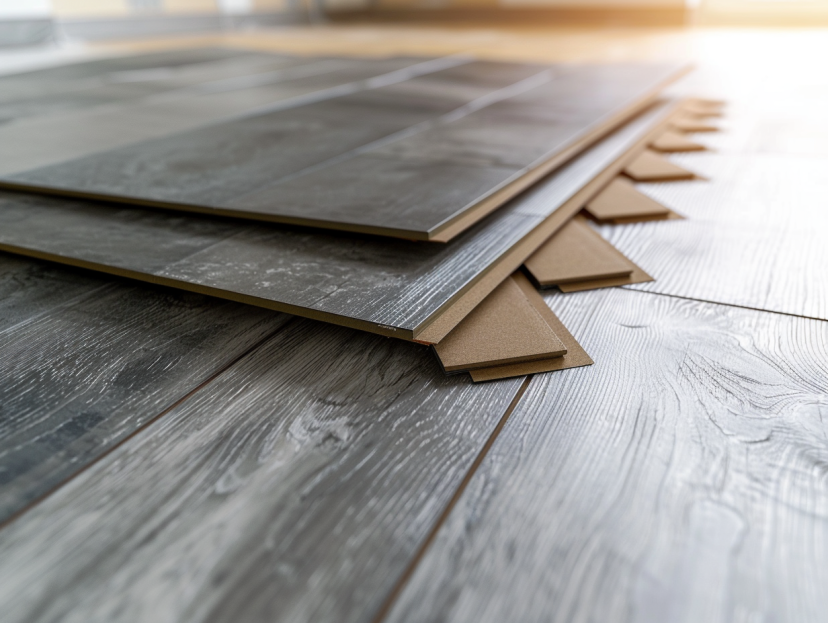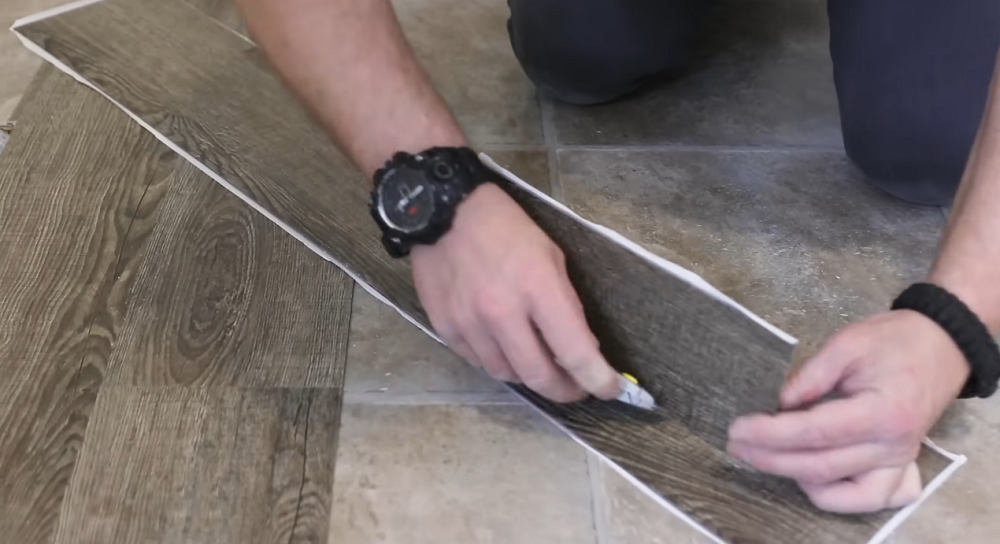Peel and Stick Vinyl Tiles is one of the easiest floors to install in your space for fresh a new look instantly. However, the proper installation to ensure long-term use will depend on the underlayment (subfloor) for the self-adhesive vinyl floor and the manufacturer’s installation instructions. With this guide, we tell you what is the best underlayment to put under peel-and-stick vinyl flooring tiles and how to prepare the subfloor for them!

What Types of Subfloor Are Perfect for Vinyl Self Adhesive Floor Tiles?
Do you want a new look for your bathroom, but you don’t feel like doing renovations? Just by replacing the floor, you can achieve a great effect. And to make things easier, choosing a vinyl floor with self-adhesive planks will make the task much simpler. These tiles are self-adhesive and easy to install, so you won’t need any additional adhesive. You’ll be able to lay them directly over an existing vinyl floor after a good cleaning. But you must prepare the subfloor surface and underlayment because to install the self-adhesive vinyl floor it must be level. It’s very important to make sure that you have a good underlayment that way your tiles stick nicely to your underlayment and you don’t have any grooves going across your tile. So for these tiles to perform well and last, the preparation involving the subfloor and underlayment is crucial. Here’s why:
1. Surface Smoothness
Subfloor and Underlayment Preparation: The subfloor is the primary surface over which the flooring will be laid. Any bumps, holes, or irregularities in the subfloor can telegraph through the peel and stick tiles, leading to an uneven surface that not only looks unprofessional but can also cause the tiles to wear unevenly or detach. An underlayment can provide a smooth, flat surface that ensures the tiles adhere evenly and securely.
2. Adhesion
Clean and Dry Surface: Peel and stick tiles adhere best to surfaces that are clean, dry, and free of dust or debris. Subfloors should be meticulously cleaned and, if necessary, leveled before installation. The underlayment can act as a clean, new surface over an older subfloor, enhancing the grip of the adhesive on the tiles.
3. Moisture Protection
Barrier Against Moisture: Moisture can severely undermine the adhesive used with peel and stick tiles. A damp subfloor can cause the tiles to curl or lift. An appropriate underlayment can serve as a moisture barrier, preventing any rising damp from affecting the tiles.
4. Durability and Wear
Protection from Wear: Properly installed underlayment can help in distributing the load more evenly across the surface. This distribution can reduce wear and tear on the peel and stick tiles, thereby extending their lifespan.
5. Sound Insulation and Comfort
Noise Reduction and Comfort: Underlayment can also provide sound insulation, reducing the noise level when walking on the floor. Additionally, it can make the floor feel warmer and more comfortable underfoot.
6. Ease of Installation
Simplifying Installation: A well-prepared subfloor and underlayment can simplify the installation process of peel and stick tiles. It ensures that tiles will lay flat and stick properly without the need for constant adjustments and reapplications.
7. Longevity
Ensuring Longevity of the Floor: Ensuring that the subfloor and underlayment are properly prepared can significantly impact the longevity of your floor. It prevents issues like shifting tiles and potential replacements in the future.
What are the Best Subfloor For Peel and Stick Vinyl Floor Tiles?
The subfloor should be clean, smooth, and free from any dust, dirt, or debris. It should also be structurally sound and level to prevent any issues with the installation. The type of subfloor surface that is suitable for peel and stick floor tiles includes:
1. Concrete Flooring
Peel and stick vinyl tiles can be installed directly on a concrete subfloor. However, you should make sure the concrete does not have any moisture problems, as wet concrete can cause mold issues. If there are concerns about moisture, underlay membranes can be installed to control and stabilize humidity. Ensure it’s level and free of cracks. Repair any damages and clean thoroughly. Use a Class 1 moisture barrier if moisture issues are suspected.
Best For: Basements, Garages, Industrial settings
2. Epoxy Flooring
Peel and stick vinyl floor tiles can indeed be installed on an epoxy floor, provided that the floor is thoroughly cleaned and prepared, ensuring it is smooth, free from contaminants, and in good condition. However, avoid installing these tiles on damaged or uneven epoxy surfaces, or in areas prone to high moisture and temperature variations, to ensure durability and effectiveness of the adhesive.
Best For: Commercial spaces, High-traffic residential areas, Areas requiring easy cleanup and durability
3. Existing Wood Flooring
Vinyl tiles can be installed on wooden floors if they are completely free of joints and even surfaces. Sanding might be necessary to level any uneven seams or rough areas to prevent them from becoming visible through the vinyl. The wood subfloor must be stable, level, and free of protruding nails or other imperfections. A Class II moisture barrier is recommended due to the porous nature of wood.
Best for: Residential areas like living rooms and bedrooms, renovations where preserving existing wood floors is desired
4. Existing Vinyl Flooring
If you have existing Vinyl flooring that has been glued down, peel-and-stick vinyl tiles can be laid on top of it without any issues. However, it is important to ensure that the Vinyl flooring is securely glued to the entire surface to prevent slipping under the vinyl tiles. Thoroughly clean the floor before installation to avoid dirt deposits.
Best for: Quick updates or budget renovations, rental properties, any area where the existing vinyl is still in good condition
5. Existing Ceramic Floor
If you want to install peel-and-stick vinyl tiles over an existing ceramic tile floor, make sure that the grout lines are no larger than 1/4 inch. If they are larger, the floor will need to be leveled using a patching compound. Remove any loose or broken areas of ceramic tile and fill them with a concrete-based thinset mortar before installing the vinyl tiles.
Best for: Kitchens and bathrooms, areas where removing old tiles is not feasible
6. Liquid Screed Flooring
Self-adhesive vinyl tiles can be installed on the screed and liquid screed, provided any unevenness over 0.5 mm is compensated. The floor should be completely sanded and vacuumed to remove dirt and irregularities before installation.
Best for: New construction, areas undergoing significant renovation, settings where a smooth and level surface
What are the Best Underlayments For Peel and Stick Vinyl Floor Tiles?
In some cases, an underlayment may be necessary to provide additional stability and smoothness to the subfloor. Here are some suitable underlayment for peel and stick vinyl floor tiles:
1. Plywood Underlayment
Plywood is a popular choice due to its strength and stability. It provides a very smooth surface when high-quality plywood is used.
Best For: General installations where a durable, smooth base is necessary.
2. OSB (Oriented Strand Board)
Although slightly less smooth than plywood, OSB can be a cost-effective and stable option for areas with less traffic.
Best For: Budget installations in low-traffic areas.
3. Fiberboard Underlayment
High-density fiberboard (HDF) or medium-density fiberboard (MDF) offers a smooth surface and is relatively easy to install.
Best For: Providing a smooth finish and moderate sound reduction.
4. Cork Underlayment
Cork is excellent for sound reduction and insulation. It’s naturally resistant to mold and mildew.
Best For: Installations over concrete subfloors where sound insulation and warmth are desired.
5. Foam Underlayment
This softer option can help smooth out minor subfloor imperfections and provide some sound dampening.
Best For: Rooms where additional comfort and warmth are needed.
6. Luxury Vinyl Underlayment
Specifically designed for luxury vinyl tiles, this underlayment often combines foam or rubber materials for enhanced sound reduction and moisture protection.
Best For: High-end installations where maximum performance is needed.
What Subfloor & Underlayment Surfaces Are Not Suitable For Self-Adhesive Vinyl Floor Tiles?
As mentioned above, we can see that self-adhesive vinyl floor tiles can be freely laid on a variety of subfloors and underlayments, and installation is very simple. However, not all surfaces are suitable for peel-and-stick tiles. Here’s a breakdown of sub-floor surfaces that are typically not suitable for peel-and-stick vinyl floor tiles:
1. Carpet or Padded Surfaces
Carpet and similar padded materials are too soft and unstable for vinyl tiles. Vinyl tiles require a solid, stable, and flat surface to adhere properly and remain durable.
2. Uneven or Damaged Concrete
Any bumps, cracks, or uneven areas can prevent the tiles from sticking properly and may cause them to lift or buckle over time.
3. Ceramic Tiles with Deep Grout Lines
While it’s possible to install vinyl tiles over ceramic, deep grout lines need to be leveled with a suitable compound first. If this is not done, the vinyl tiles will eventually conform to the grout lines, leading to uneven wear and potential tearing.
4. Unsealed or Dusty Concrete
Concrete floors must be sealed and thoroughly cleaned. Dust, dirt, or moisture trapped under vinyl tiles can cause them to fail to adhere correctly and may lead to mold growth.
5. Floating Floors
Floors that are not permanently attached to the subfloor, like floating laminate or wood floors, are not suitable for peel-and-stick tiles. The movement of the floating floor can cause the vinyl tiles to shift, leading to edges that may lift or curl.
6. Waxed or Polished Surfaces
Surfaces treated with wax, polish, or some types of gloss finishes can prevent the adhesive on the tiles from sticking effectively.
7. Outdoor or Non-Climate Controlled Areas
Areas that are not controlled for temperature and humidity, such as outdoors or in non-insulated sheds, can have conditions that weaken the adhesive on the vinyl tiles.
8. Old Vinyl Floors That Are Peeling or Curling
If the existing vinyl floor is not in good condition (e.g., peeling, curling), it can compromise the new installation. The old floor should be completely removed or repaired to a stable state before new tiles are installed.

